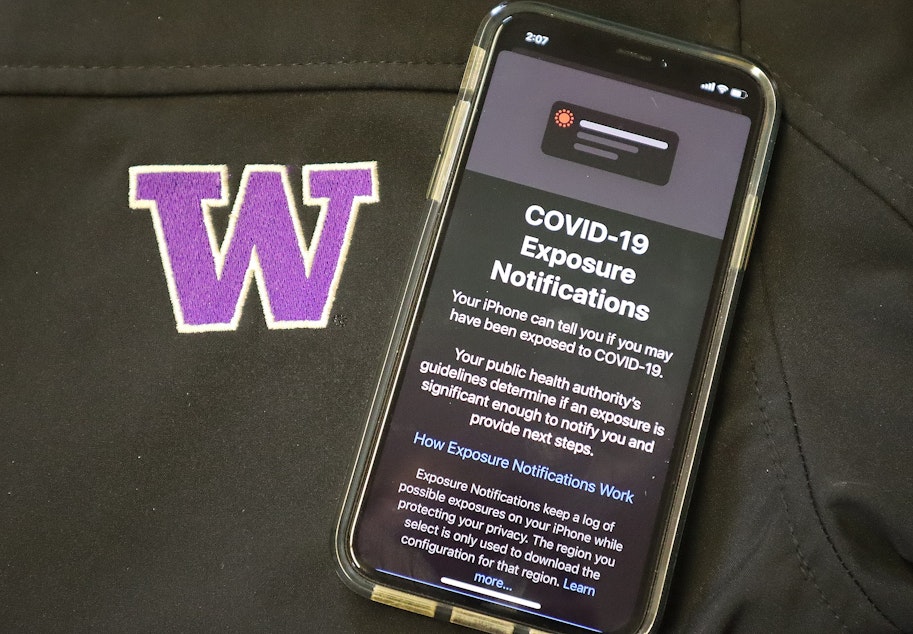Want to know when you've been exposed to COVID-19? There's an app for that

University students and staff in the Pacific Northwest are giving a trial run to a smartphone app that tells you if you were recently near someone who just tested positive for COVID-19. State health departments are rolling out similar apps across the country to slow the spread of the coronavirus.
Beta testing on a COVID-19 exposure notification app began earlier this month at Oregon State University and the University of Washington under the oversight of state health authorities. Associate Dean of the UW School of Public Health Janet Baseman was one of the first to opt in among what are now thousands of pilot project participants.
"These notifications may be really helpful for pandemic control," Baseman said. "Given the privacy protections, I felt pretty confident downloading this app to my phone."
Here's how the free app works. You voluntarily opt in with your smartphone. The phones of participating users monitor when other users linger close by (using Bluetooth functionality). Your phone stores a rolling 14-day log of people you have been around, but anonymized, so it doesn't actually store real names or any location info. If a person you lingered near later tests positive for the virus, the app sends a confidential note to you of a possible exposure. You are then advised to seek a follow-up COVID test.
"This is not an alternative to traditional contact tracing. It is additive," said Steve Clark, vice president for university relations at OSU and also a beta tester.
Sponsored
Baseman explained the smartphone app offers several advantages, including faster notice to users that they had a potential exposure to a known COVID case. In addition, it can cover gaps in contact tracing stemming from when an infected person can't remember or is reluctant to share the names of all the people they hung out with while infectious.
"The other interesting thing that this technology can do for us is have exposure notification messages go out to people who never would have been identified as a close contact through traditional contact tracing," Baseman said, thinking of users who lingered around other people they don't know personally.
In Washington state, the health department is tentatively aiming for a December statewide "go live" date.
"While the pilot runs, the state is simultaneously preparing for a statewide rollout, which includes conducting focus groups and surveys with key populations and preparing training materials for local health jurisdictions, as well as marketing materials," said Washington State Department of Health spokesperson Amy Reynolds in an email.
An Oregon Health Authority spokesperson said Tuesday that the university pilot project results would inform the "next steps" toward a wider rollout in Oregon.
Sponsored
Clark said the Oregon State University exposure notification app testing is expected to last four to six weeks.
One of the biggest hurdles in the way of wide adoption of the COVID-19 exposure notification technology could be lack of trust in government and Big Tech. Another potential hiccup could happen when users who test positive hesitate to share their status with the app so it can alert other users who have been near them. Users must voluntarily input their positive COVID-19 test results.
The more people who activate the notification app, the greater the potential to help contain the currently uncontrolled spread of the virus, said the app developers.
Baseman said based on modeling she had seen from Europe, if 15 percent or more of the population participated, "it can have real benefit in terms of reducing forward transmission, reducing additional cases and deaths."
The fast adoption of the smartphone technology on university campuses in Corvallis, Bend and greater Seattle gives some reason for optimism. Clark said more than 6,500 members of the OSU community enrolled in the first few weeks the notification app was available. Baseman said the UW pilot project had more than 3,500 users as of Tuesday.
Sponsored
Google and Apple jointly created the underpinnings of the exposure notification system, which individual states are now customizing for their residents. The exposure notification capability is built into the latest iPhone operating system. Apple iPhone users will just have to opt-in under the "Settings" menu to activate it once notifications are available in their jurisdiction. Android phone users have to download an app from the Google Play store.
Fifteen other U.S. states plus the District of Columbia have already launched their versions of the COVID-19 exposure notification app. The most populous state, California, is starting out in similar fashion to its West Coast neighbors with a pilot project at seven University of California campuses.
Copyright 2020 Northwest News Network

